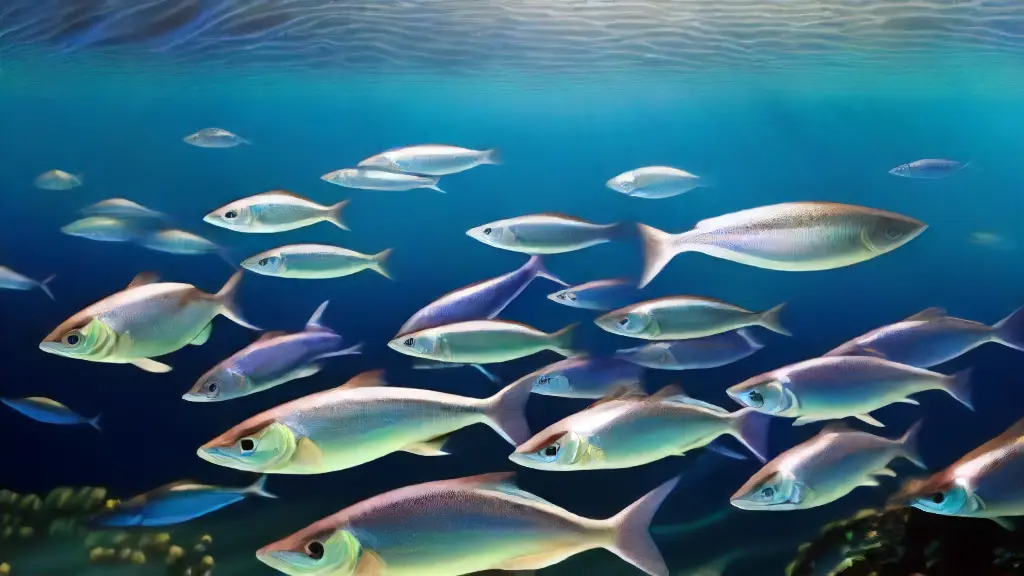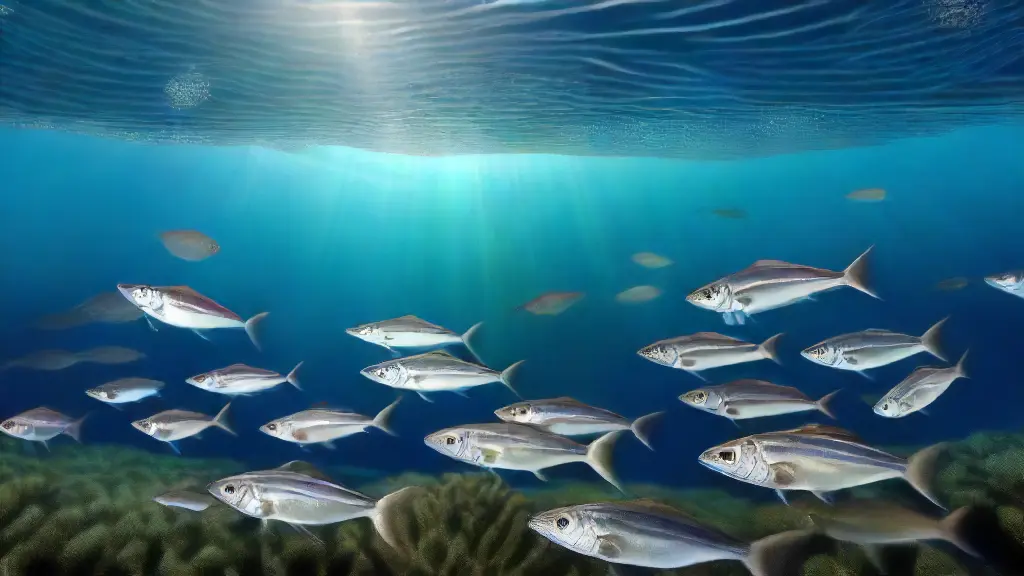How Bait Fish Behavior Changes with Water Depth

The way fish interact with their environment is fascinatingly complex, with subtle changes in the aquatic setting influencing their behavior in profound ways. In the shallower regions of our waters, the adjustments made by bait fish have a significant impact on their effectiveness as bait.
Changes in water depth significantly impact bait fish behavior, making them more or less effective as bait.
This phenomenon affects not only the type of bait used but also the fishing techniques employed.
In the first 3 feet of water, bait fish exhibit a unique behavior, grouping together in large schools to feed. This schooling behavior is crucial, as it allows them to capitalize on abundant food sources. At this depth, bait fish have specific feeding patterns, targeting particular food sources with remarkable aquatic adaptations.
Aquatic Behavior at Shallow Depths
In the intricate dance of aquatic life, the slightest changes in water depth can have a profound impact on the behavior of small fish, with significant implications for the delicate balance of their ecosystems.
The role of small fish, often referred to as baitfish, in ecosystems is multifaceted, serving as a vital food source for larger predators while also contributing to the overall health and diversity of the environment.
Understanding baitfish behavior is essential, as it influences the dynamics of predator-prey relationships and the structure of aquatic communities, making it a key area of research in ecology and conservation.
Water depth is a crucial factor in shaping baitfish behavior, with subtle shifts in patterns often occurring as depths transition from 0-3 feet, a range that can harbor diverse plants and structures. As baitfish forage, their patterns of movement and behavior adapt to the intricate structures and plants, influencing their life trajectories and avoidance of predators.

How Do Fish Respond to Pressure Changes
Fish have evolved unique traits to thrive in diverse aquatic environments, where subtle cues govern their survival and success.
The pressure change response is a critical aspect of fish behavior, as it affects their physiology and influences their movements, feeding patterns, and social interactions.
Despite their remarkable adaptability, fish face significant challenges when navigating changing pressure environments, which can impact their spatial awareness and habitat selection.
Pressure and water depth have a profound impact on fish physiology, as changes in pressure can influence the amount of oxygen available in the water, affecting their breathing patterns and overall health.
The migratory patterns of some fish species are influenced by changes in pressure, which can affect their feeding habits and social interactions.
In response to changes in pressure, fish adapt by slowing down their metabolism, reducing their activity levels, and altering their feeding habits to conserve energy. By doing so, it increases migratory birds’ spatial awareness of their cues and habitat selection.
| Pressure Change Response | Impact on Fish Physiology | Adaptations |
|---|---|---|
| Affects breathing patterns and overall health | Influences amount of oxygen available in water | Slowing down metabolism, reducing activity levels, and altering feeding habits |
| Impacts spatial awareness and habitat selection | Influences migratory patterns and social interactions | Increases spatial awareness of cues and habitat selection |
What Role Do Plants Play in Bait Fish Habitat
In the midst of aquatic environments, a delicate balance exists between the physical and biological components, with plants playing a vital role in shaping the intricate web of life among bait fish. Bait fish habitat and water depth are intimately connected.
Water depth determines the availability of food sources, with shallow waters often hosting more abundant and diverse food webs.
As a result, bait fish have evolved to adapt their feeding patterns to the water column, exploiting pockets of dissolved gases and navigating the complex chemistry of different depths.
Bait fish are most active in the upper 3 feet of the water column, where they can exploit the abundant food sources and navigate the thermoclines.
This critical threshold depth of 3 feet has a significant impact on baitfish behavior, influencing everything from their schooling patterns to their attractiveness to anglers. The connection between water depth and baitfish behavior is complex, influenced by the unique environments, column depth, and thermoclines that affect the dissolved gases and chemistry, which in turn impact the physiology of the baitfish.
How Does Depth Influence Foraging Patterns
The complex interplay between fish and their aquatic environment is fundamentally shaped by the dimensional aspect of water depth, which presents a multitude of habitats that dictate the evolution of diverse foraging strategies.
Water depth significantly influences baitfish behavior, with changes in attractiveness and avoidance patterns as depth increases. In shallow waters (0-3 feet), baitfish exhibit structured behavior, minimizing avoidance and maximizing attractiveness.
This is likely due to the abundance of food sources and reduced predator presence.
Conversely, in deeper waters (10+ feet), baitfish adopt structured behavior with high avoidance and low attractiveness, suggesting a greater emphasis on survival over foraging.
In environments with artificial reefs or niches, these patterns may be disrupted or amplified. The water column can be divided into three zones: top, middle, and bottom. Each zone presents unique dynamics, habitats, vegetation, artificial reefs, and niches that support distinct populations.
Facts About Fish Behavior
- Baitfish exhibit structured behavior in shallow waters (0-3 feet), minimizing avoidance and maximizing attractiveness.
- In deeper waters (10+ feet), baitfish adopt structured behavior with high avoidance and low attractiveness, suggesting a greater emphasis on survival over foraging.
- The water column can be divided into three zones: top, middle, and bottom, each presenting unique dynamics, habitats, vegetation, artificial reefs, and niches that support distinct populations.
- Water depth significantly influences baitfish behavior, with changes in attractiveness and avoidance patterns as depth increases.
Can Bait Fish Cues Convey Danger
Wandering through the watery realm, we stumble upon a peculiarity that has piqued the curiosity of many – the intriguing behavior of bait fish. These small, schooling fish play a vital role in the intricate web of marine life, their actions serving as a vital indicator of the ocean’s rhythms.
In the depths of the ocean, changes in bait fish behavior are closely tied to the benthic gradients.
In the midst of the darkness, (10-20 meters), bait fish tend to lead solitary lives, only occasionally feasting on small, suspended prey.
As the depths decrease, however, they flock together in community, frequenting shallower waters to devour larger, settled prey. In the shallows (up to 3 meters), their feeding habits are abundant, with specific schooling patterns the norm. Adjusting to their surroundings, the microbes thrived in the community where the temperature fluctuations matched the subtle gradients across the logs, sediments, and benthic zones.
Why Do Fish School in Certain Zones
In the ever-changing environments of aquatic ecosystems, turbulence reigns supreme, setting the stage for a delicate balance of life and survival. The dynamics of water flow and substrates create a complex tapestry of microhabitats, where fish must adapt to thrive.
One of the most fascinating aspects of fish behavior is their tendency to school in certain zones.
But why do they do this? The answer lies in the advantages of foraging together.
By schooling, fish can increase their chances of finding food, evade predators, and even communicate with each other.
Water depth plays a significant role in shaping fish behavior.
Different species have evolved to thrive in specific depths, where they can exploit unique oxygen levels and escape predators. For example, baitfish that feed on surface-dwelling insects may school in shallow waters, while those that feed on bottom-dwelling organisms prefer areas with gentle flow near oxygen-rich interfaces overlying substrates with varied microhabitats that promote turbulence.
| Turbulence | Water Depth | Food Sources | Predator Avoidance |
|---|---|---|---|
| Increases chances of finding food | Determines species’ evolution and survival | Surface-dwelling insects, bottom-dwelling organisms | Evade predators through schooling |
| Creates complex tapestry of microhabitats | Species-specific depths for exploitation | Insects, organisms | Communication through schooling |
| Essential for fish survival | Shallow waters for baitfish, gentle flow for others | Surface-dwelling, bottom-dwelling | Foraging together increases chances of survival |
What Effects Does Spatial Awareness Have on Behavior
The intricate dance of species and their surroundings has long fascinated scientists, with spatial awareness playing a crucial role in shaping the behavior of countless creatures.
Baitfish, particularly those found in shallower waters, exhibit unique feeding patterns that are deeply connected to their spatial awareness.
For instance, in areas with moderate to high water clarity, baitfish often feed near the surface, where visibility is best.
In deeper waters, where visibility is reduced, baitfish tend to gather in schools around structures like drop-offs, reefs, and sunken logs, where their spatial awareness helps them navigate boundaries between different ecologies.
The morphology of a body of water also influences the behavior of baitfish. For example, in rivers and streams, the constant flow of water creates a unique geography that baitfish adapt to, using their spatial awareness to navigate transitions and find food in the ever-changing climate.
How Do Thermoclines Affect Bait Fish Life
Beneath the surface of lakes and reservoirs, a subtle yet significant phenomenon occurs, influencing the lives of bait fish and their inhabitants. Weather conditions may seem calm and tranquil, but beneath the surface, temperature gradients are forming, shaping the behavior and distribution of bait fish.
Water Depth and Bait Fish Distribution: Bait fish congregate in specific water depths, driven by factors such as food availability, habitat suitability, and predation avoidance.
In areas with thermoclines, bait fish often concentrate in the upper or lower regions, depending on the temperature gradient.
Water temperatures that exist in a state of equilibrium, characterized by a clear distinction between warm and cold water layers, have a profound impact on the distributions of bait fish. Conditions that foster the growth of aquatic plants and invertebrates, in turn, influence the abundances of bait fish, which ultimately affect the states of various fishing activities and migrations.
Bait Fish Distribution
- Bait fish congregate in specific water depths, driven by factors such as food availability, habitat suitability, and predation avoidance.
- In areas with thermoclines, bait fish often concentrate in the upper or lower regions, depending on the temperature gradient.
- Water temperatures that exist in a state of equilibrium, characterized by a clear distinction between warm and cold water layers, have a profound impact on the distributions of bait fish.
- Conditions that foster the growth of aquatic plants and invertebrates, in turn, influence the abundances of bait fish, which ultimately affect the states of various fishing activities and migrations.
Best Practices for Using Bait Fish in Clear Water
Best Ways to Mimic Bait Fish Behavior with Lures


